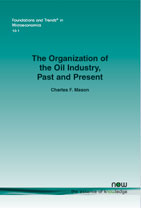The Organization of the Oil Industry, Past and Present
By Charles F. Mason, University of Wyoming, USA, bambuzlr@uwyo.edu
Abstract
For several decades, petroleum has been a commodity of vital importance to the global economy, in which a number of interesting market phenomena has occurred. This monograph represents my efforts to describe several of these phenomenon, along with a few other elements of the oil market. My focus is on elements related to the extraction of petroleum, and the interactions between buyers and sellers of crude oil; issues that are essentially linked to the Industrial Organization of crude oil markets The topics I cover are: the production of crude oil, material that provides a foundation for later material; an example of the behavior employed by John D. Rockefeller in his quest for control of the early petroleum refining industry; the excessive extraction phenomenon observed in the early days of the industry, which was obtained because of the "common property" nature of oil production; the historical battle between the major oil companies (who were collectively dubbed the "Seven Sisters" and Organization of Petroleum Exporting Countries, or [OPEC]); a theoretical discussion of cartel formation, which forms the backdrop for an investigation of OPEC; an empirical model of membership in OPEC; and a handful of key recent events, which offer some insights into the future of the oil industry.
The Organization of the Oil Industry, Past and Present
The Organization of the Oil Industry, Past and Present explains the various shifts in the balance of power between a group of large international vertically integrated firms (the Seven Sisters), and a group of oil producing countries (OPEC) in the fight for control over global oil markets. The article focuses on elements related to the extraction of petroleum, and the interactions between buyers and sellers of crude oil, as well as issues that are essentially linked to the Industrial Organization of crude oil markets.
The Organization of the Oil Industry, Past and Present is organized as follows. After a brief introduction, Section 2 discusses the production of crude oil. Section 3 sheds light on the objectionable practices of John D. Rockefeller in his pursuit of control of the early petroleum refining industry. Section 4 discuses the problem known as the "rule of capture," as it relates to the excessive extraction of crude oil in the early days of the industry. Section 5 explains the tension and power shifts between the Seven Sisters and OPEC. Section 6 provides a conceptual discussion of cartel behavior that investigates the role played by reserves as a basis for Section 7, which empirically analyzes this conceptual result. Section 8 concludes the monograph by considering the impacts of recent events on the future of the oil industry.
